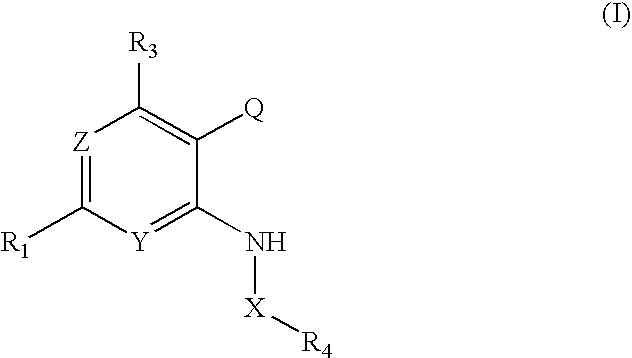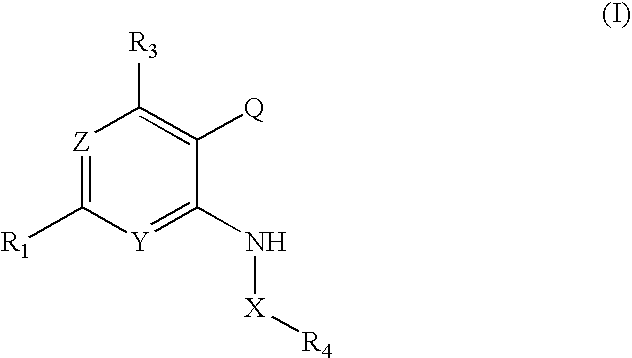Pyridopyrimidinone Inhibitors of PIM-1 and/or PIM-3
- Summary
- Abstract
- Description
- Claims
- Application Information
AI Technical Summary
Benefits of technology
Problems solved by technology
Method used
Image
Examples
example 1
4-Chloro-2-{[(2,5-dimethylfuran-3-yl)carbonyl]amino}benzoic acid
[0342]In a 2 mL vial, methyl 2-amino-4-chlorobenzoate (7.4 mg, 40 μmol) was dissolved into a mixture of 655 μL DCE and 120 μL DMA, followed by addition of DIPEA (600 μmol, 15 eq.). 2,5-Dimethylfuran-3-carboxylic acid (16.8 mg, 120 μmol, 3 eq.) and POCl3 (18.2 mg, 120 μmol, 3 eq.) were added. The reaction mixture was capped and stirred at room temperature overnight. Another 700 μL of DCE was added to the reaction mixture along with the following resin bound reagents: a resin bound diethylene triamine (PL-DETA, Polymer Labs, 297 μmol, 7.4 eq.) and a hydroxide ion exchange resin (PL-MP Hydroxide, Polymer Labs, 800 μmol, 20 eq.). The vial was recapped and shaken at room temperature overnight. The resin in the reaction mixture was filtered off, rinsed with 300 μL of MeOH and discarded. The combined filtrates were concentrated down in vacuo. The residue was re-dissolved into 1 mL of DMA and 280 μL of 1M aqueous NaOH. The solu...
example 2
5-Chloro-2-(1H-tetrazol-5-yl)aniline
[0343]5-Chloro-2-(1H-tetrazol-5-yl)aniline: 2-Amino-4-chlorobenzonitrile (1000 mg, 6.6 mmol), sodium azide (555 mg, 8.5 mmol) and triethylamine hydrochloride (1175 mg, 8.5 mmol) were taken up in 15 mL of toluene. The suspension was heated to 100° C. overnight. After cooling, the reaction mixture was washed 3 times with 5 mL portions of water. The combined aqueous fractions were acidified with concentrated hydrochloric acid. The desired 5-Chloro-2-(1H-tetrazol-5-yl)aniline precipitated from aqueous solution and was isolated by filtration (1090 mg, 85% yield). 1H NMR (500 MHz, DMSO-d6) δ 7.73 (d, 1H), 6.97 (d, 1H), 6.74 (dd, 1H); MS (electrospray) m / z 196 (M+H).
example 3
4-Chloro-2-[({4-[4-(methyloxy)phenyl]-2-thienyl}carbonyl)amino]benzoic acid
[0344]In a 2 mL vial, methyl 2-amino-4-chlorobenzoate (7.4 mg, 40 μmol) was dissolved into a mixture of 655 μL DCE and 120 μL DMA, followed by addition of DIPEA (600 μmol, 15 eq.). 4-(4-Methoxyphenyl)thiophene-2-carboxylic acid (13.7 mg, 120 μmol, 3 eq.) and POCl3 (28.1 mg, 120 μmol, 3 eq.) were added. The reaction mixture was capped and stirred at room temperature overnight. Another 700 μL of DCE was added to the reaction mixture along with the following resin bound reagents: a resin bound diethylene triamine (PL-DETA, Polymer Labs, 297 μmol, 7.4 eq.) and a hydroxide ion exchange resin (PL-MP Hydroxide, Polymer Labs, 800 μmol, 20 eq.). The vial was recapped and shaken at room temperature overnight. The resin in the reaction mixture was filtered off, rinsed with 300 μL of MeOH and discarded. The combined filtrates were concentrated down in vacuo. The residue was re-dissolved into 1 mL of DMA and 280 μL of 1M ...
PUM
| Property | Measurement | Unit |
|---|---|---|
| Composition | aaaaa | aaaaa |
Abstract
Description
Claims
Application Information
 Login to View More
Login to View More - R&D
- Intellectual Property
- Life Sciences
- Materials
- Tech Scout
- Unparalleled Data Quality
- Higher Quality Content
- 60% Fewer Hallucinations
Browse by: Latest US Patents, China's latest patents, Technical Efficacy Thesaurus, Application Domain, Technology Topic, Popular Technical Reports.
© 2025 PatSnap. All rights reserved.Legal|Privacy policy|Modern Slavery Act Transparency Statement|Sitemap|About US| Contact US: help@patsnap.com



